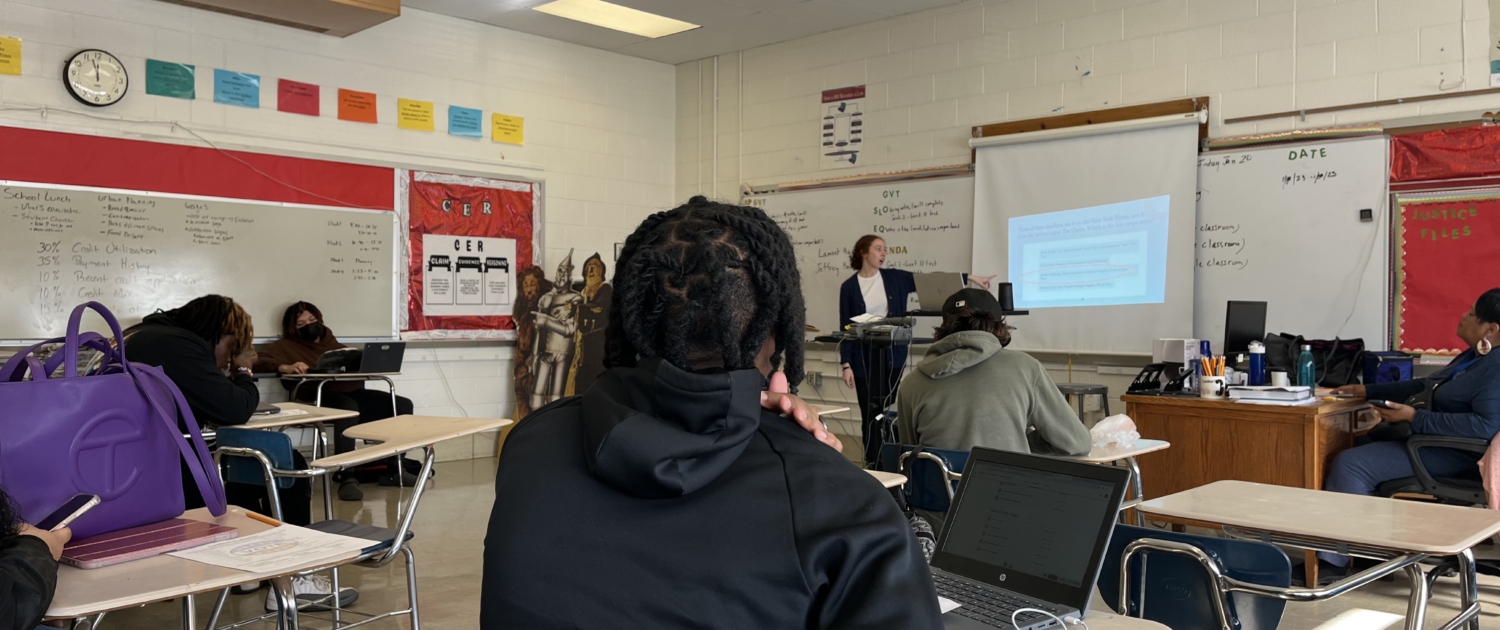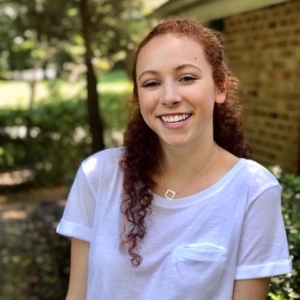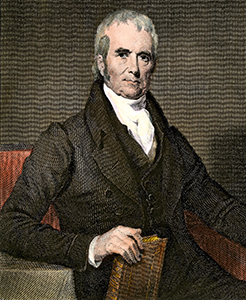Pop Civ 22: Justice in the Classroom On Site at John Marshall High School
For this installment of PopCiv, we’re checking in with JMC Site Lead Educator, Sarah Hanlon, about her experience working with the U.S. Government students at John Marshall High School in Richmond, Virginia, for the pilot program of Justice in the Classroom On Site, generously supported by the Virginia Law Foundation. Continue reading below to learn about Sarah’s experience working with the JMHS students.
Piloting a New Program
During the Fall 2022 semester, the JMC partnered with Richmond’s John Marshall High School for a program focused on constitutional history and civics. This program featured six lessons, which explore the judiciary, John Marshall’s judicial legacy, landmark Supreme Court cases, and civic responsibilities. Students also learned how to navigate difficult conversations with their peers and how they could become involved in their local government.
When I was hired as the site lead educator, I was excited to use my teaching experience in a new way. I have always had a passion for social studies education, and especially enjoy working with students on the subjects of civics and government. I think that it is so important for high school students to have a basic understanding of how our government works (which is something many adults don’t even know!). My excitement for the subject area is ultimately what brought me to this program.
Creating the lessons for the six modules was a fun challenge. I worked closely with Dr. Milondra Coleman, the U.S. Government teacher whose class I would be visiting. My challenge was combining factual details about the courts, judicial review, and constitutional history while also packaging the information and activities in a way that would be interesting to teenagers.
I designed the lessons to foster student participation, and included elements of current events and pop culture in order to engage their attention. Each class included a slideshow for the students to view as I led the classroom in discussion, activities that students would participate in as small groups, and a writing component to help record student progress. Dr. Coleman also participated in our discussions, which helped some of the more timid students feel comfortable jumping into the conversation.
The lessons prioritized opportunities for student participation, rather than instructor lecture, and as a result, students directed most of our discussions. The dynamic structure of these programs was meant to help students grasp the concepts they were learning about. We also hoped that our lessons would spark an interest in civic engagement for the students, who may have previously found the topic uninteresting.
The six curriculum modules covered the following topics, The Marshall Court, Rule of Law, Mediation skills, Judicial Review, The Court system, and student involvement in government. Below you will find brief descriptions of what each module entailed to get a better idea of what the students were learning and doing in each lesson.
Students from Dr. Coleman’s Government class at John Marshall High School listen in as JMC Site Lead Educator Sarah Hanlon leads a lesson about Constitutional History.
Our first module focused on how students could become more comfortable having difficult conversations with peers. This module uses skills developed by legal mediators to equip students with the tools they need to communicate with empathy. The group learned how to ask open questions, mirror a speaker’s body language, and avoid using judgemental language. The students then participated in a debate about whether there should be lifetime appointments to the Supreme Court, using the communication tools they had just learned.
The second module introduced students to the Marshall Court and the concept of judicial review. The students learned about John Marshall’s role as the Great Chief Justice, and how the decision in Marbury v. Madison shaped the nation’s judicial system. Afterwards, the students reviewed several additional landmark Supreme Court cases which involved high school students, and applied their new understanding about judicial review to their exploration of those cases. The students found this particularly interesting, as it gave some explanation to certain elements of their own high school experience. One example is JMHS students are required to have their bags searched each morning, which was deemed legal in the landmark case TLO v. New Jersey. Talking about this case helped the students connect Supreme Court decisions to their own daily lives, and we had a great class discussion on the subject.
In the third module, we discussed Rule of Law. The first part of the lesson explores what “rule of law” means in the United States. We then compared rule of law in the U.S. to rule of law in other countries. Afterwards, students worked in small groups to analyze quotes that related to the concept. This helped students understand the importance of rule of law and how it is applied in real world scenarios.
The fourth program centered around an activity that connects Marbury v. Madison to Brown v. Board of Education. Using judicial review as a throughline, the lesson plan helped students connect the establishment of the judiciary’s power to review the constitutionality of laws to the eventual abolition of segregation laws in the U.S.
For our fifth session, the students dove into a lesson about the federal court system. We held a discussion about the court and the various roles found in a courtroom. The students then looked at a current court case involving two celebrities to help them better understand those roles. Afterwards, the class moved into the discussion on careers in law. To showcase some key skills needed to have a career in law, the students participated in a debate over which fast food restaurant they felt was better. The students acted as either the attorney for their fast food restaurant or as the jury. This activity was designed to show the students some of the skills needed for a career in law. This activity sought to show students what a career within the law field would entail, as well as to inspire the students to think about their future careers and where they can use the skills that they already have. This activity was a hit with the students!. I never thought that debating fast food would bring out such passion in high school students, but they each took their roles seriously in the debates and brought great energy to the classroom.
In the last module, which focused on civic responsibility, the students first determined what community issues they care about and what they would value in a candidate who was running for office. The students then looked at two sample candidates for an imaginary local election and debated which candidate they all would vote for. This activity helped students learn how to differentiate between candidates and prioritize the issues that were most important to them. Afterwards, as a class, the students went through a lesson on media bias by comparing and contrasting articles from a wide range of major news outlets. The students also had a chance to learn about the difference between satire and factual reporting.
The students continuously surprised me throughout this program. They all openly shared their opinions and points of view in each class discussion. They weren’t afraid to disagree with me, each other, or even their teacher when expressing their perspectives. These students already have such established views and passions that I hope, with the help of this program, they are now equipped with the skills to put that enthusiasm to use to make a real difference in the world.
I really liked that our program combined core constitutional history and civics lessons with modern day impacts on young people; I feel that the importance of this program lies in the students. By conducting this program to upperclassmen in a high school government class, the JMC resources provided something that students can actually use as they enter the “real world.” I loved being able to cover a range of topics, from civics basics, to how to register to vote, to careers opportunities in the legal profession, to having difficult conversations. I hope that he students I worked with will find the JMC’s lessons useful as they enter adulthood. Lastly, this program taught me about the value of education in fostering civic engagement. The amazing students at JMHS already had the desire and energy to get involved in their communities, and now they have the knowledge and tools to do so.
Meet our JMC Site Lead Educator:
Sarah Hanlon is a graduate of Christopher Newport University. She earned a Bachelor’s degree in History, a minor in Political Science, and was a member of the Phi Alpha Theta Historical Honor Society. In addition to working as a History Teacher and Mentor at Fusion Academy in Tyson’s, Virginia, Sarah worked as an Intern at the Waterman’s Museum in Yorktown, Virginia. She has also served as the Executive Board Member and Historian for the Student Virginia Education Association at CNU.







